Grasping for hope: the residents of a village in Kharkiv Oblast and their fight to rebuild their life
While fighting continues on the front lines of Ukraine, people attempt to rebuild their lives in recently liberated territory. This is especially true in the case of the village of Dovhenke, which has changed hands more than ten times during the conflict.
December 10, 2023 -
Kateryna Pryshchepa
-
UkraineAtWar
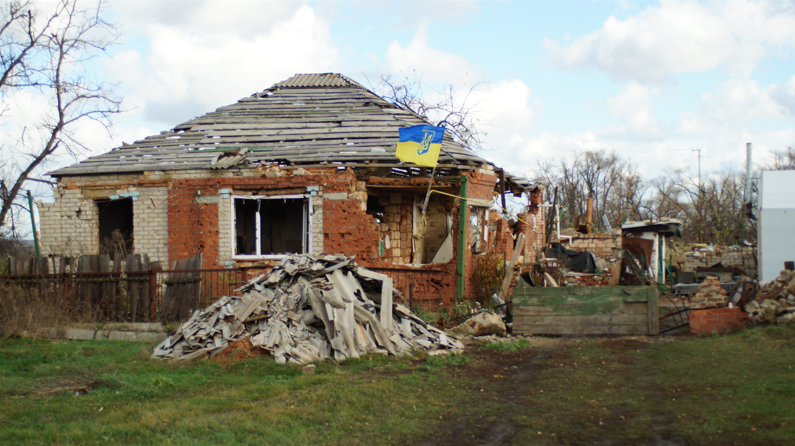
A damaged house in Dovenke, a few hundred meters from where Nataliia. The owner has been trying to clear the backyard of mines.
At a certain point, reports from the areas affected by the war risk becoming quite repetitive. You see the destroyed villages, the remnants of destroyed military and civilian vehicles lying by the roadside, and signs warning of the danger of mines. But it is visiting not one but many of such places which makes you realise the scale of the war and the damage it has caused. And even after having seen dozens of damaged towns and villages some scenery can still hit you. This is true in Dovhenke, a village in Kharkiv Oblast only 20 kilometres south of Izium. The distance from here to Sviatohirsk, which is already in Donetsk Oblast, is even less. In the spring of 2022 this quiet village became a flashpoint for fierce military action when the Russian army was pushing from Kharkiv Oblast towards Donbas. It is estimated that the village had been lost and retaken by the Ukrainian army more than ten times between spring and autumn 2022. When in September 2022 the Ukrainian army retook control of the village, there was no building left undamaged in the village. In November 2023, more than a year since the successful Ukrainian counter offensive in the region, most of the buildings in Dovhenke lay in ruins. There are no electricity or gas supplies, most of the village has not been cleared of mines, and the local authorities are reluctant to say if or when the village will be reconstructed.
I visited Dovhenke in November 2023 with a group of Kharkiv volunteers who are bringing a small power generator to one of the residents, a school teacher named Nataliia Demchenko. Since returning to the village, she has been teaching online and says she could teach more classes if only she had a reliable power source for her laptop.
At this point, there are only 20 to 24 people who live in Dovhenke permanently. A sharp contrast to the 700 to 800 people who were residing here at the beginning of 2022. Some of the former residents had been already internally displaced, having come to Kharkiv Oblast from war-torn Donbas in 2014. The residents who returned to the village this year say even more would like to come back if only the village could get help with rebuilding. Eager to return to their life as it was before the Russian invasion, Dovhenke residents placed a banner calling for the village’s restoration as you enter the area.
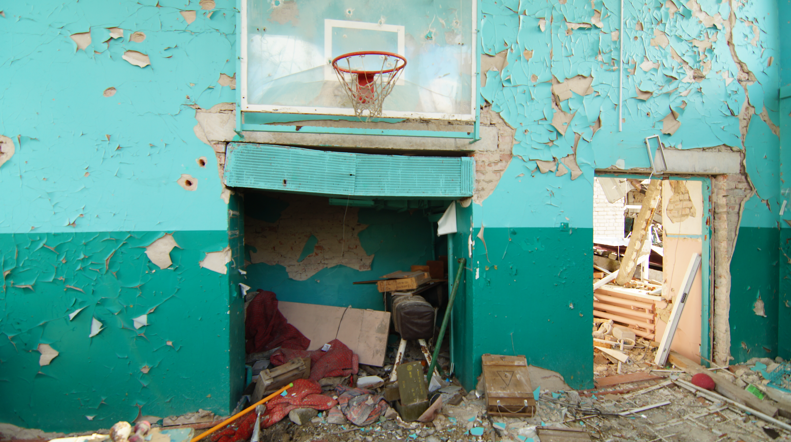
The interior of the school gym in Dovhenke
Right at the entrance to the village there is a monument to soldiers who fell in the Second World War. The monument representing a standing soldier’s figure lacks its head. It had been cut off by shelling in 2022. So were the tops of the trees around the monument and all the rest of the trees in the village. The gravestone for the mass grave is also in disrepair. We can see it standing on the road outside the fence around the monument but we do not cross the gate to take a closer look. The grass is too high and the spot clearly had not been cleared of potential explosives yet.
First thing we see when the car stops by Nataliia’s house is a big Ukrainian flag at the corner of the building. The day is windy and the flag is fluttering with some noise. While we are getting out of the car, another group stops to say hello to Nataliia and her husband Dmytro. Their neighbours had come to the village to bury a family member who died in Dnipro.
Nataliia is one of the very few Dovhenke residents who came back to the village after it had been liberated by the Ukrainian army. She says her family was lucky. Although damaged by the shelling, her house was in a state which allowed for renovation. “There was no roof left and the walls needed drying up. We had to put in all the windows anew and there are still dents in the walls on the outer side of the building. But this all could be dealt with. Our local authorities had distributed the construction materials and our elder son, who lives in Kharkiv, found the workers who did the repair,” says Nataliia.
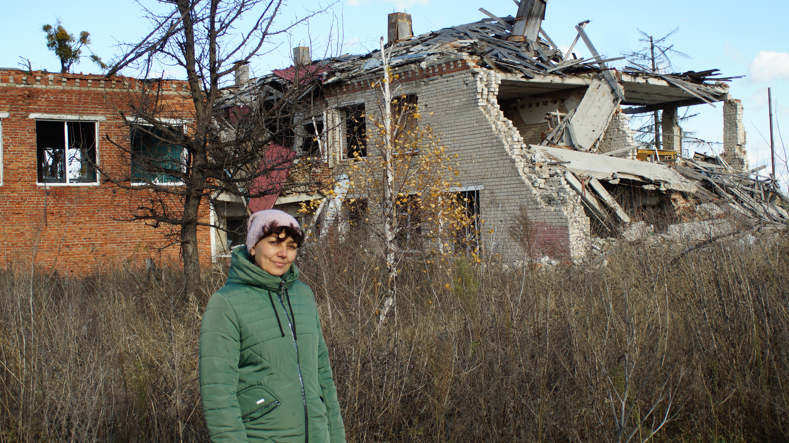
Nataliia in front of the Dovhenke school she used to teach at.
Fleeing the fighting
Like most Dovhenke residents, Nataliia and her husband left the village in March 2022 fleeing the heavy fighting. “It had been quiet in Dovhenke for some days in March 2022 and we even had hoped that maybe the fighting would not affect us, although back in 2014 Ukrainian army units had been stationed here when the war in Donbas began,” says Nataliia. However, already on March 13th the Russian military dropped several bombs on the village, damaging the electricity supply infrastructure and some public buildings. “They have been deliberately targeting our public infrastructure right from the start – the school, the community centre and electricity transformers,” says Dmytro.
Nataliia and Dmytro were reluctant to leave at first as they had been rearing pigs and had 35 of them. “But then our Ukrainian soldiers told me: do you want to die for the pigs? I saw it all clearly. I was responsible for my parents and my wife, so by the end of March we had left and a Ukrainian army unit had moved into our house’s basement,” says Dmytro. The family temporarily moved to the Poltava region where their in-laws hosted them for more than a year.
They did not come back to live in their home until 2023. “I was working in a school in Poltava region and left after the end of the 2022-23 school year,” explains Nataliia.
Dmytro started to work on their land plot in spring this year. “There were dozens of small mines here and I couldn’t wait for the authorities to clear them. So I got on with the demining myself. I was working on my knees cutting and checking the grass by small handfuls. When I would find a mine I would call the military to come and take it away,” he explains.
He sowed corn on the cleared plot almost a hectare big. When we go to see it, Nataliia warns us not to step off the path. “We only walk over these clearly visible roots where the grass had been trampled and you can see what you are stepping on,” she explains. She goes on saying that some weeks ago a young soldier had wandered into the grass close to one of the houses in the village and had lost his leg as a result of a mine explosion.
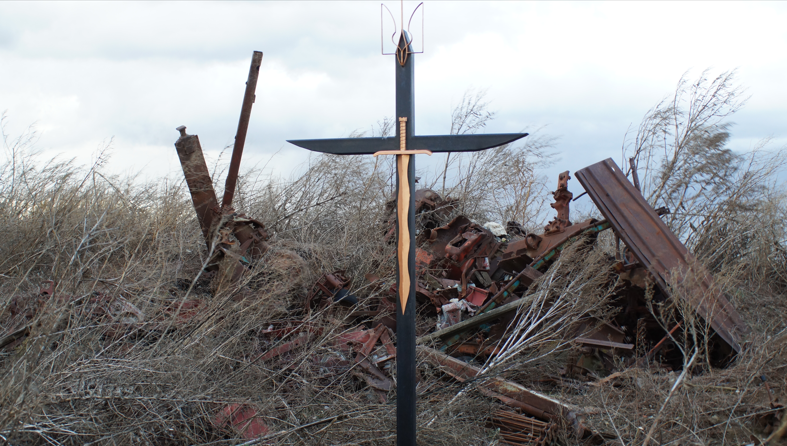
A cross erected on the territory of a large industrial farm in Dovhenke in the memory of the fallen Ukrainian soldiers by their family members.
The ghost town
Dmytro and Nataliia take us on a walk in the village. The local outpatient clinic lies in ruins and grass now grows in the former clinic premises. “My children had literally grown up here. My mother-in-law is a doctor and used to work here,” Nataliia says.
The village school had been damaged by a bomb and later shelling, but we can still go inside on one side. Dmytro takes us along the safer parts of the corridors. In one of them we see the poster representing the most famous Ukrainian poets Taras Shevchenko, Ivan Franko and Lesya Ukrainka. Someone had cut their eyes out with a knife.
Dmytro takes us to the school museum. It was supposed to be a village museum but he explains that they had managed to develop the part dedicated to the Second World War the most. Standing in front of the posters detailing the local history of the conflict, Dmytro says that it was actually logical that such heavy fighting took place in Dovhenke in 2022. “It was the same during World War Two,” he says. Dovhenke is located at the highest altitude in the Kharkiv region. “You can see Izium from the window and those who control Dovhenke can control the whole area around here. You know, there were more than 4000 people buried in the Second World War grave here. That is how heavy the fights had been,” he goes on saying.
We go on along the corridors and stand some metres away from the destroyed outer wall of the building. Through the hole in the wall we can see the destroyed village store and community centre and looking to the right through the window of one of the classes – the destroyed village clinic.
Dmytro, who had not been to the school building for some time, notices something new looking through one of the windows. He points to the green ammo cases behind the school in what used to be the sports ground. He thinks it is most likely the ammo left by the Russians. He explains that “I couldn’t see it before, the grass was green and too high, and we don’t go to that patch yet. It had not been cleared of the mines.”
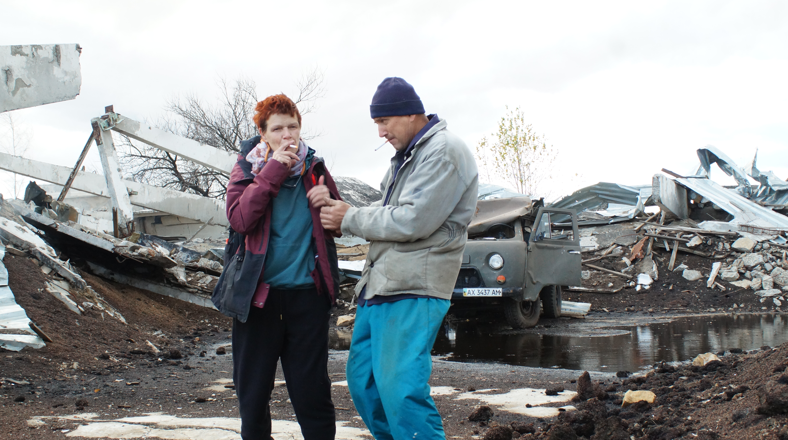
Czech photographer Iva shares a cigarette with Yurii, who guards the farm.
Millions worth of damage
Before 2022, most of the village residents had been engaging in small-scale farming, raising pigs or growing vegetables for sale. But there had also been two big industrial scale farms. We go to see what was left of one of them. Yurii, the guard, takes us around. The scenery is depressing. There is millions of dollars’ worth of destroyed agricultural machinery scattered across several hectares of territory. The farm had been bombed and later became the spot of fighting between Ukrainian and Russian army units. The machinery had no chance to survive. In one of the corners of the farmyard there is a several dozen metre wide crater. A bomb exploded over a pile of saltpeter bags.
Close to the crater amid the rubble there is a new metal cross. Yurii explains that several Ukrainian soldiers had been killed here and the families came and put the cross here when they could.
The smell of smoke gets to our nostrils. Some dozen metres away from the crater, there is a slow fire in the destroyed grain storage. The grain harvested back in 2021 did not have a chance to get to the markets. Sitting under the open sky for more than a year it had gone rotten. Instead of taking it out from under the rubble of the storage, the company workers tried to set it on fire, just to eliminate most of it.
There are occasional “bad surprises” in the storage. “We found the remains of a dead Russian soldier in the grain,” Yurii says. The army says there could be up to five more in there.
For now, the farm workers are trying to repair the machinery that is possible to salvage in the farm’s repair shop. It is hard to say if the farm workers will be sowing in the spring. The fields around Dovhenke are mined and it is hard to say when they will be cleared.
The winter with Hygge
After the walk in the village, the return to Nataliia and Dmytro’s house is a relief. Like many of the buildings in the village, the house and the shed close to it still have graffiti left by Russian soldiers on the walls. They have left the names of the villages they came from. “People ask me why I don’t paint over them,” Nataliia says, “but it would require more than one coat of paint to paint over those. It is too much of an expense for us at the moment”.
At home Nataliia demonstrates her working station. She teaches her classes from her bedroom. The room’s window faces to the south, giving her the best light during the day. “Many of our students are now abroad and go to schools there, but the parents still want them to continue with the classes in Ukraine. So to fit their schedule, our classes begin in the afternoon,” Nataliia explains. Having taught mathematics for more than 30 years, Nataliia had to find a new place to work when she came home. Due to the destruction of the village school building and the dispersion of the students, the Dovhenke school is officially closed now. Nataliia teaches in a school in Kapytolivka, the village that belongs to the same Oskil municipality as Dovhenke.
Nataliia places her laptop on the bedside table and has a small chalkboard behind her. “The fully charged battery gives me six hours of work, which is enough for me to hold one class five days a week,” she explains. On the weekends her laptop would be taken to Izium, where many Dovhenke residents have found temporary refuge, to be charged. “People try to stay close to the village and many come here at least once per week so there is always someone to take the laptop to charge and bring it back.”
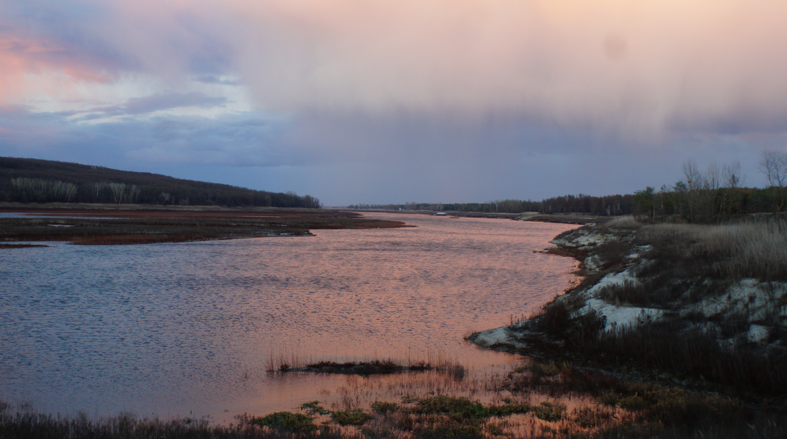
What remains of the Oskil water reservoir in Kharkiv oblast. The reservoir dam was hit by a Russian bomb in April 2022.
Nataliia says she has adapted to life without electricity by now. She cooks on a portable gas stove fuelled with the gas from a 100-litre gas canister. The house is heated by wood and there are battery powered portable lamps in several rooms. But the inability to power her laptop had been hampering Nataliia’s ability to work. “If I have a stable source of electricity, I could teach more than one class a day,” she explains. So the new generator provided by the European donors will come in handy.
Nataliia does a test run of the generator. She was worried if she could start it herself. Most of the time she is staying in the house alone. Her elder married son lives in Kharkiv and the younger one has been serving in one of Ukraine’s paratrooper brigades for more than four years now. Dmytro, Nataliia’s husband, was mobilised into the Ukrainian army some months ago. His service as an aid in the Kharkiv military hospital gives him an occasional chance to come to Dovhenke, but he is away most of the time.
Despite all this, Nataliia is keeping a positive outlook on life. At her bedside table there is a Ukrainian edition of a “Hygge” book. “I bought it myself recently. When my granddaughter was born I signed up for a postal book delivery service and they have been sending us catalogues all the time. When I saw this one on sale, I decided to place an order,” Nataliia says. She says the book provides some relief and a glimpse of optimism. Like all the rest of her purchases, the book had been delivered to Izium and one of her neighbours in the village had brought it to Dovhenke on one of their occasional visits. Reading and work will be the things that will keep Nataliia busy and entertained during the winter alone in the house in her destroyed village.
All photos by Kateryna Pryshchepa.
Kateryna Pryshchepa is a Ukrainian journalist and a contributing editor with New Eastern Europe.
Please support New Eastern Europe's crowdfunding campaign. Donate by clicking on the button below.

































